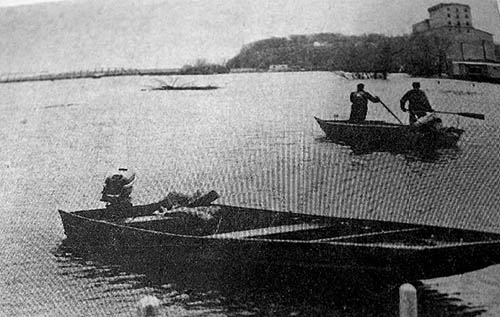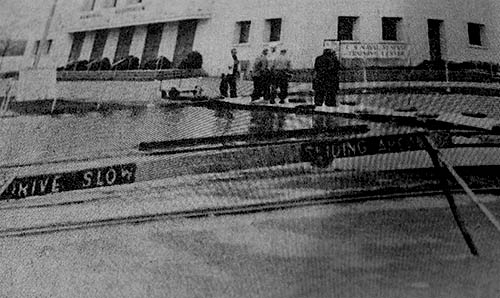Burlington Flood of 1965
Burlington, Des Moines County, Iowa
Amanda Lund
April, 1965

In April of 1965, Robert Lumberg of Burlington felt the effects of a flood that would result in the loss of fourteen lives, the displacement of 15,000 people, and over $125 million dollars of damage. After a week of sandbagging of the levee adjacent to his home, Lumberg made the decision to move. He determined the time to be right “when the water comes in faster than you can mop it up”.
Heavy snowfall during March of 1965, when between 40 to 60 inches fell in Minnesota and Wisconsin, combined with temperatures that were 10 to 15 degrees below normal for the month. The temperatures prevented the gradual melting of the snow, and when temperatures finally rose in April, the fast melting snow created a rush of water into the Mississippi. Additionally, the region experienced between 2 ½ and 3 ½ inches of rainfall that was unable to soak into the still-frozen ground. The rain filled waterways, causing the Mississippi to reach record flood levels by mid-April.

On April 19th, Lumberg packed the basement of his home, located near the Iowa River-Flint Creek Levee 16, on a corner of a right-of-way that had recently been acquired in connection with the proposed raising of the levee. He had evacuated his family a week prior but continued to sandbag in hopes of avoiding a move. “If it weren’t for the seepage water I probably would not be leaving,” said Lumberg.
The infiltration of floodwaters into homes and water supplies was a primary concern for health officials. On April 30, 1965 the Burlington Hawk-Eye printed an article stressing the importance of obtaining typhoid vaccines. The series of three injections was recommended for those who experienced flooding in their homes and those helping with clean-up. Mrs. Jean Johnson, the Des Moines county health nurse, stated, “The typhoid germ is carried by water supplies and food that has been contaminated by flood water which at this time carries a large amount of raw sewage. As the Mississippi recedes back into its banks, it will leave behind many deposits of germs in water supplies in puddles of stagnant water, virtually everywhere it has extended an ugly arm.”
Downtown, the Burlington Memorial Auditorium endured the Mississippi’s rising levels with sandbags and gangplanks. Donated boats were operated by Naval Reservists to transport fuel and sand to levee workers to preserve the building that was constructed in 1939.
On April 30, the river crested at 21.0 feet, surpassing the previous record of 18.9 feet set in June of 1951. Lumberg, who had previously encountered flooding when he began building his home in 1957, stated that he would not be fazed by the potential dangers of the river. “I’ll be back, but I plan to build back from the right-of-way.”
